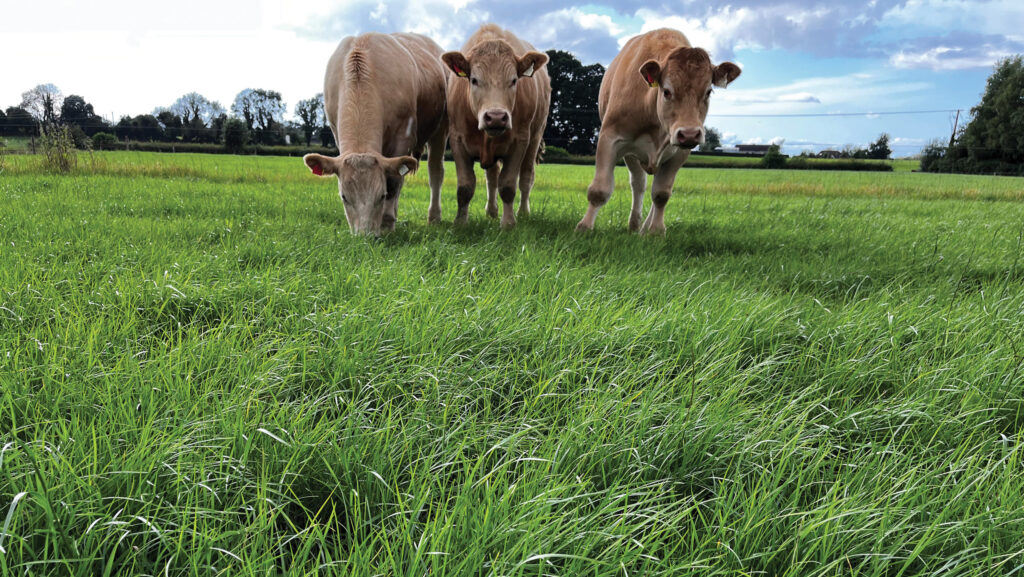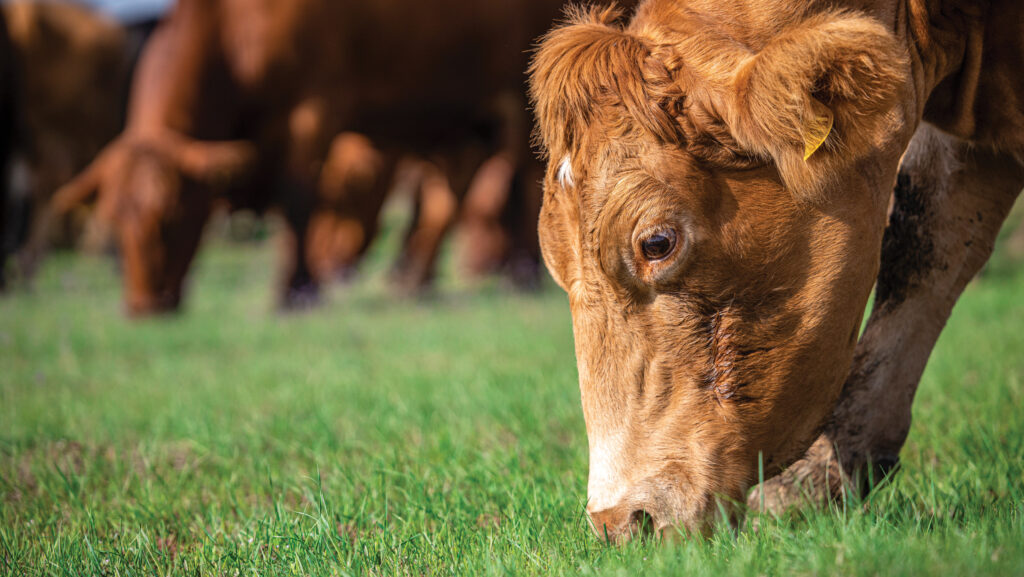How higher grazing residuals increase beef cattle liveweight gain
 © Teagasc
© Teagasc Beef cattle which graze pasture to a residual of 5-6cm in all rotations – except the first and last of the season – are likely to gain more weight than those forced to take covers down further.
Trials at Irish research body Teagasc has shown that although grazing grass to a relatively low post-grazing sward height will increase grass utilisation, it can negatively impact on the intakes and performance of beef animals.
See also: Guide to grazing systems
In one study, yearling beef-cross Holstein Friesian steers (at grass for one season) were 30kg lighter at slaughter after grazing to a residual of 3.5cm, compared with animals that had grazed to 5cm.
The liveweight gain of suckler calves at grass with their dam pre-weaning was also analysed.
At weaning, calves were an average of 8-10kg lighter when they grazed pasture to 4cm instead of 5.5cm.
Grazing to 6cm
The trend was similar in suckler-bred steers in a weanling-to-beef system.
After a 200-day grazing season, yearlings that had grazed to a residual of 6cm, were on average 29kg heavier at housing than the group grazing to 4cm.
They also had a slaughter carcass that was 15kg heavier after both groups had been finished indoors for the winter.
Teagasc grassland research scientist Dr Peter Doyle says that, if cattle had been drafted for slaughter to allow all to achieve the same carcass weight, it is estimated the lower-residual group would take a month longer to finish.

© Adobe Stock
Peter says the studies demonstrate that if cattle are forced to graze too tightly, they are unlikely to achieve their full growth potential.
The reduction in daily liveweight gain (DLWG) in cattle grazing to a lower residual is a direct result of decreasing intakes.
“When an animal is turned into a field of fresh grass, it will graze a third of the height of the grass that is available at that point,” says Peter.
“It will have its highest intake at that point because, as it continues to graze down through the sward horizon, it will always be taking one-third of the height of the grass that is there.
“So as the grass gets shorter, the animal’s bite depth must be lower and, as a consequence, intake decreases.”
More grazing bites
Cattle compensate by taking more grazing bites per day, he adds.
“That can help for the lower bite depth, but it gets to the point where if cattle are [forced to graze] too severely and there is not much grass, their number of grazing bites might not continue to compensate because they will be anticipating a move to fresh pasture.”
In all systems, a balance should be struck between DLWG and maintaining grass quality. Post-grazing residuals should never be higher than 6cm.
“There will be a huge amount of dead material left behind and it will be of inferior quality,” Peter suggests.
It is a reason why he recommends grazing to a 4cm residual, in the first and final rotations of the season.
In the opening rotation, a lower residual encourages regrowth of higher quality grass.
“If the post-grazing sward height is too high, or herbage mass is too great, it can be hard to regain grass quality for the rest of the year,” he explains.
Grazing to 4cm in the final rotation will allow light to get to the base of the sward over the winter rest period, which encourages tillering and thickening of the sward.
“It is good practice to graze out tightly towards the back end of the year so that you have good quality grass at the start of the spring grazing season.”
Lower grass yield
There are trade-offs from leaving a higher residual to capture greater weight gain.
In the Teagasc study involving the suckler-bred yearling steers in the weanling-to-beef system, grazing to 6cm resulted in a grass yield that was 0.5t DM/ha lower.
The stocking rate had to be 15% lower, too.
The study did not look at the economics of lost grass yield and stocking density, compared with the returns of achieving higher weights and a quicker finishing time.
But Peter points out that stocking rates in Irish beef systems are less of a limiting factor than on dairy farms, and overall DLWG/ha was similar for the 4cm and 6cm systems.
As well as capturing higher cattle performance, grazing to 6cm could also help the beef industry achieve environmental targets set by governments.
In Ireland, the beef industry target is to reduce its greenhouse gas emissions by 25% by 2030, and slaughter age by three months.
If beef farmers can increase performance over the lifetime of an animal by 30kg as a result of making changes to grazing, it will achieve its finishing weight a month sooner, says Peter.
He adds that other factors such as genetics and health can further speed up those finishing times.
He emphasises that the research was carried out in grass-only pasture, not in swards containing clover – and that is an important point of difference.
“Clover is an important species in grassland systems to fix nitrogen and improve animal performance.
“But if you want to maintain its content, swards must be tightly grazed, to allow light down to the clover stolons at the base.”
How performance can be influenced by pre-grazing herbage mass
The mass of pre-grazing herbage offered to cattle can affect their performance, according to two studies by Teagasc.
Yearling steers in a suckler weanling–to-beef system were allocated a pre-grazing herbage mass of either 1,500kg dry matter (DM)/ha or 2,500kg DM/ha in spring.
(In the UK measuring system this converts to 3,000kg DM/ha and 4,000kg DM/ha respectively.)
The cattle rotationally grazed for 200 days. Pastures were not topped during the trial.
Cattle were then housed in November, fed grass silage supplemented with minerals and vitamins, and slaughtered at about 24 months.
At the end of the grazing season, the liveweight of the animals on covers of 1,500kg DM/ha (3,000kg DM/ha) was 16kg/head heavier.
There was, however, no difference in carcass weight at the end of the indoor finishing period.
The digestibility of the grass offered was higher in the lower herbage mass due to a greater leaf and lower stem content.
Teagasc grassland scientist Dr Peter Doyle says the results suggest that the better individual animal performance in the lower pre-grazing herbage mass was the result of greater grass digestibility.
“On average, the 1,500kg DM/ha (3,000kg DM/ha) herbage mass had a 29-day rotation length during the entire grazing season.
“This would be down at 21 days during peak grass growth in the summer,” he says.
Cattle behaviour
Cattle behaviour observed during the studies suggested that getting animals to graze to a lower residual doesn’t necessarily make them unsettled.
As creatures of habit, Peter Doyle says the cattle in the group grazing to 6cm residuals appeared to be the most unsettled when they were being moved.
“There was more bawling in these groups than in the groups grazing to 4cm,” he says, adding this was because cattle knew they would not have to graze the sward down further and would soon move to a new paddock.
